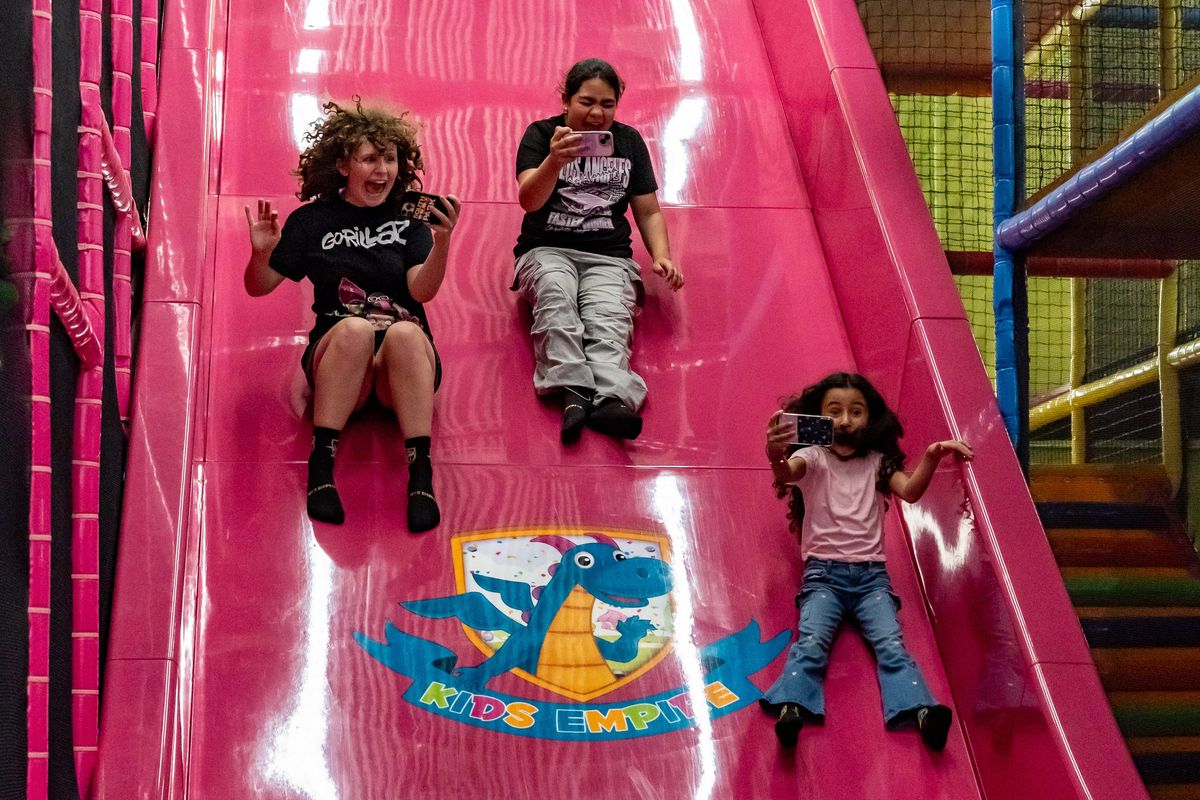What I'm going to share here may well be futile, and many people who need to hear this message and take it to heart probably won't. But America is at a precipice we've been hurtling toward for years, and if we don't do something now to slow the momentum, I fear we'll soon find ourselves plummeting over a proverbial cliff, one and all. It's worth an attempt to pull us back from the brink.
We all know that political polarization in the U.S. is reaching a fever pitch. What many people don't seem to recognize is how they individually play a role in it, especially those who are adamant that the "other side" is to blame for the division. As a lifelong political independent, it's been terrifying to watch my fellow Americans become more and more entrenched in hyper-partisanship, seemingly unaware of how they themselves are contributing to the problem, simply by allowing themselves to be pulled further into the partisan binary.
 We can't divide America into "left" and "right." Photo credit: Canva
We can't divide America into "left" and "right." Photo credit: Canva
Democrats say Republicans are the problem. Republicans say Democrats are the problem. The vast majority of us absentmindedly use black-and-white ideological terminology that line up with our political parties to describe our fellow Americans—liberal or conservative, left or right, red or blue—as if 342 million people fit neatly into two political/ideological boxes. As a result, many Americans have found a home and an identity in those boxes, and unfortunately, some have built them into fortresses from which to shoot at the other side—figuratively and literally.
But no matter how people feel about one box or the other, neither of them is really the problem that brought us here. The problem is the premise that they are built on, which is that there are two opposing sides in the first place. It was inevitable that partisanship in a two-party system would eventually leads to an intractable division featuring extreme, binary thinking pushed by those who benefit from that polarization. The "other side" isn't just different, it's depraved. The 'other side" isn't just misguided, it's malicious. The "other side" isn't just wrong, it's evil. This kind of thinking is a feature, not a bug.
 George Washington tried to warn us about the perils of partisanship. Giphy
George Washington tried to warn us about the perils of partisanship. Giphy
George Washington tried to warn us about this in 1796 when he said that the "spirit of party" was America's "worst enemy" and would eventually lead us to our demise. We're right there, right now. Partisanship has been fully weaponized by those seeking and wielding power, pitting Americans against Americans, convincing them that the "other side" isn't just wrong, but evil. ("But the other side really is evil!" you might be thinking. Thank you for proving the point. The "other side" says exactly the same thing.) The walls of those political and ideological boxes have gotten so high and so thick that we've lost the ability to see one another's humanity.
Many things have gone into how we got here, of course, and there's plenty of blame to be tossed around. But instead of finger pointing when we talk about our polarization problem, what if we were to look inward and own our own individual part in it, whatever that might be?
I would love to invite every American of every persuasion to take a pause, zoom out, and honestly engage with these self-reflection questions:
Do I tend to label people as liberal/left or conservative/right based on what I know about their beliefs?
Do I assume a certain political party affiliation based on what someone looks like/how they dress/where they live?
Do I describe states and cities as "blue" or "red" and make judgments about those places based on those labels?
Do I use generalized terms like "the left" or "the right" to describe large swaths of the American population?
Does the media I watch or listen to speak in those binary terms? Is one used positively and one used negatively?
 Partisanship is divisive in its very nature.Photo credit: Canva
Partisanship is divisive in its very nature.Photo credit: Canva
Do I check multiple sources to find what's true before I react or form an opinion about something I see on social media?
Do I seek out a variety of commentary to genuinely try to understand different perspectives?
Do I contact my legislators when I want to see a change in policy, or do I just argue with people on social media about it?
Do I recognize when people are debating in an effort to seek truth and when they're using rhetorical tricks to "win" an argument?
Am I spending more time engaging with people online than I am in real life?
Do I pay more attention to the extreme voices on the political spectrum than to the moderate ones?
Am I aware of how social media algorithms affect what I see and am exposed to?
Do I see how the extreme element of the "side" I most align with is being used to paint my political persuasion in a negative light?
Do I see how the same thing is being done with the extreme element on the other "side"?
Do I acknowledge when someone from my "side" shares misinformation? Do I call it out?
 There''s b.s. all over the political spectrum. Giphy
There''s b.s. all over the political spectrum. Giphy
Do I think of a large portion of my fellow Americans as enemies or adversaries? Why do I view them that way?
Do I want to see my fellow Americans as enemies or adversaries? How can I see them differently?
Am I suggesting we stop using labels like left/right, liberal/conservative, etc. altogether? As much as possible, yes. These labels barely help us understand one another anymore—most often they are used to stereotype people or to take one person's objectionable action and ascribe it to the entire "side." So much of our current situation is a result of the extreme generalization of Americans into two groups, when in reality, very few people actually think, believe, live, and act within the confines of however those group labels are defined. Most of us know this intellectually, of course, but it's so easy to be pulled by language to one extreme or the other in a polarized political climate, especially via social media.
That polarization is purposeful, by the way. Giving people a political identity and an "other side" to fight against is one of the easiest ways to gain political power. Unfortunately, it's also playing with fire. (And if you think only one party does it, think again. It's just much easier to spot when it's done by people we disagree with.)
We can't solve our problems using the same means by which they were created. We can't change the politics that weaponizes partisanship if we ourselves are furthering and fueling it with partisanized thinking and rhetoric. We can't respond to political and ideological extremism with more extremism, even if we think our extremism is justified. Literally every extremist thinks their extremism is justified. Black-and-white, us vs. them thinking is extremism. It's becoming so common, we're getting numb to it.
None of us is immune here—this stuff is designed to tap our most primal instincts—but we have to fight it in ourselves. When we feel a push or pull toward binary extremes (which is easily mistaken for believing we're on the righteous side of things) we can consciously pull ourselves back to a place where we see one another's humanity before everything else.
I'm not both-sidesing here or implying that there aren't any legitimate issues with any particular party/side/ideology. What I'm saying is that partisanized discourse has become a zero sum game and too many Americans are willingly being used as pawns in it. While we can't control what other people do, we can reflect on the part we as individuals play and dedicate ourselves to being part of the solution instead of contributing to the problem.
Of course, stepping away from political labels and partisanzied discourse won't instantly solve all of our issues as a nation. But if enough Americans refuse to play the partisan game and reject the binary rhetoric of left/right, liberal/conservative, red/blue, Democrat/Republican, perhaps we can help prevent the U.S. from plunging into the dark, dangerous chasm we've found ourselves at the brink of.
It's worth a shot, at least.


 A handwritten note with the words "good job!" on it
A handwritten note with the words "good job!" on it A man smiling
A man smiling A dad with his kid on his shoulders
A dad with his kid on his shoulders Sandra’s granddaughter, E’s daughter, and another friend at an indoor park (July 2025)
Sandra’s granddaughter, E’s daughter, and another friend at an indoor park (July 2025) One of the ladies Sandra sponsored from Venezuela and her partner during Sandra’s first visit to meet her (December 2023)
One of the ladies Sandra sponsored from Venezuela and her partner during Sandra’s first visit to meet her (December 2023) We can't divide America into "left" and "right."
We can't divide America into "left" and "right."  George Washington tried to warn us about the perils of partisanship.
George Washington tried to warn us about the perils of partisanship.  Partisanship is divisive in its very nature.
Partisanship is divisive in its very nature. There''s b.s. all over the political spectrum.
There''s b.s. all over the political spectrum.  Im Old Tv Shows GIF by PBS SoCal
Im Old Tv Shows GIF by PBS SoCal  Kelsey Grammer as Dr. Frasier Crane in 1996By US Treasury Dept. Public Domain
Kelsey Grammer as Dr. Frasier Crane in 1996By US Treasury Dept. Public Domain